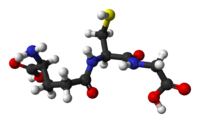
Photo from wikipedia
At the organelle level, pathogenesis due to abnormal concentrations of cysteine (Cys) is of great significance for the early diagnosis and treatment of related diseases. Generally speaking, organelle localization requires… Click to show full abstract
At the organelle level, pathogenesis due to abnormal concentrations of cysteine (Cys) is of great significance for the early diagnosis and treatment of related diseases. Generally speaking, organelle localization requires the participation of specific target groups, which increases the difficulty of synthesis. Herein, through simple synthesis, a novel biflavone derivative (BFD) that exhibits excited-state intramolecular proton transfer (ESIPT) was obtained and successfully located in mitochondria without target groups. The probe BFD can distinguish Cys from Hcy and GSH with a rapid response (< 5 s) and showed visual detection for Cys with a large Stokes shift (about 260 nm). Because of its nanomorphology in solution and surface functional groups, the probe BFD can enter the cell smoothly and achieve mitochondrial localization. Owing to its excellent optical performance, the probe BFD was successfully applied to the imaging of endogenous Cys in HeLa cells and zebrafish.
Journal Title: Chemical communications
Year Published: 2021
Link to full text (if available)
Share on Social Media: Sign Up to like & get
recommendations!